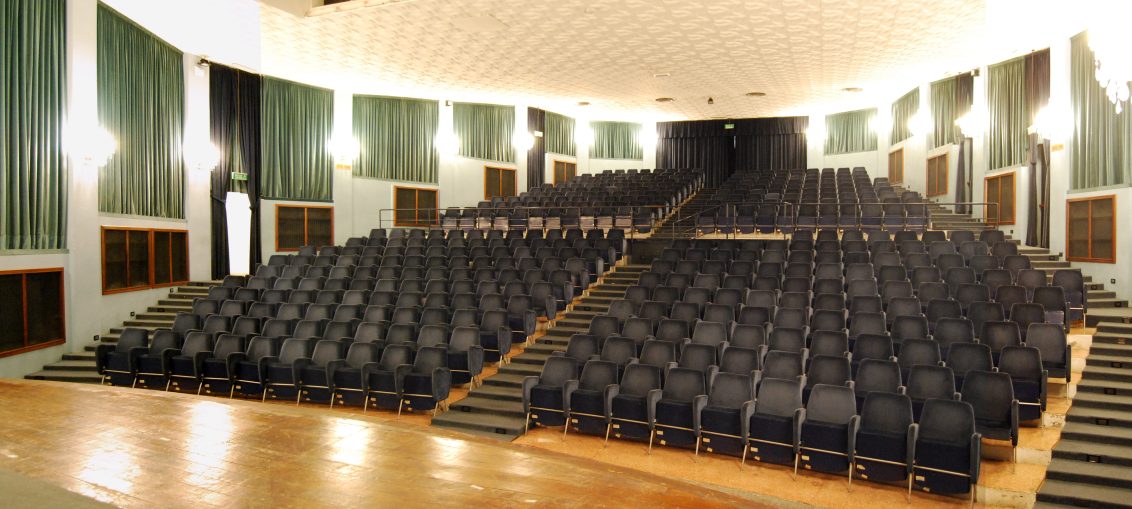
Fu inaugurato nel maggio del 1960 dopo tre anni di lavori grazie all’impegno e alla lungimiranza di Lirio Arena, Antonio Fazi e del Ministro Tambroni, con l’obiettivo di far rinascere ad Ancona il teatro drammatico e dare ai suoi artisti un luogo nel quale realizzare le rappresentazioni in maniera continuativa.
La sala degli spettacoli si caratterizzava per un ampio palcoscenico con boccascena di 12 metri, profondo 18 metri e con tre piani girevoli, impianto stereofonico ed apparato luci all’avanguardia. La platea poteva ospitare 320 spettatori seduti ed il teatro era completo di bar, foyer, sala prove, camerini e direzione. In attesa della riapertura del Teatro delle Muse, lo Sperimentale divenne il teatro cittadino e per finanziarne le spese di gestione fu costituito un comitato di sostenitori che diede solidità finanziaria consentendo alle migliori compagnie italiane di esibirvisi. Nel 1965 nacque l’Ente Autonomo Assistenza Artisti Marchigiani per sostenere il teatro dorico.
Nel 1967 si decise di ampliare il teatro con l’acquisto dell’area circostante, ma la morte nel 1968 del direttore artistico Lirio Arena colpì duramente lo Sperimentale e rallentò l’iter decisionale. I lavori di ampliamento furono avviati solo nel 1974 dopo la risoluzione delle difficoltà economiche e burocratiche.
La riapertura al pubblico avvenne nel 1979.
Teatro Sperimentale “L. Arena – via Redipuglia 59
Teatro Sperimentale
EXPERIMENTAL THEATRE “LIRIO ARENA”
The theatre opened in May 1960 after three years of construction, thanks to the efforts and foresight of Lirio Arena, Antonio Fazi and the Minister Tambroni, with the aim of giving new impulse to drama in Ancona, and give the arists long-lasting and stable premises.
The show room had a large stage with a 12 metres proscenium, 18 metres deep, and with three turntables, stereo equipment and cutting edge light machines.
The theater had a capacity of 320 spectators and also bar, foyer, rehearsal room, dressing rooms and offices. Waiting for the Teatro delle Muse to open again, the “Experimental“ became the city’s main theatre and a committee of supporters was founded to finance its operating expenses. Eventually, the theatre could afford the best Italian actors. The Ente Autonomo Assistenza Artisti Marchigiani was founded in 1965 to support the theatre and its artists.
In 1967 the land surrounding the building was bought with the intention of expanding the theatre. However, the death of the artistic director Lirio Arena in 1968 was a hard hit and slowed down the process. It was only in 1974 that the renovation work could actually begin, after economic and bureaucratic complications. In 1979 the theatre opened to the public once again.
TEATRO SPERIMENTALE (experimentelles Theater) Lirio Arena
Das Theater wurde Mai 1960, nach einem dreijährigen Aufbau, eröffnet. Es ist das Ergebnis der Bemühungen und Weitsicht von Lirio Arenas, Antonio Fazis und des Ministers Tambroni. Es wurde aufgebaut um das Wiederauflebens der Schauspielerei in Ancona zu neu entfachen und um ein langfristige Gebäude zu haben.
Die große Bühne belegte 12 Metern Vorbühne und war 18 Meter tief. Sie verfügte über drei Drehfläche, Stereoanlage und fortschrittliche Beleuchtungsanlage. Das Theater könnte 320 Zuschauern aufnehmen und belegte ein Bar, Foyer, Garderobe, und Büros. Als das Teatro delle Muse noch geschlossen war, wurde das “Sperimentale” zu Haupttheater der Stadt. Ein Komitee von Anhängern wurde um Betriebskosten zu finanzieren, gegründet. Endlich könnten die beste Schauspieltruppe im Theater spielen. Die Organisation Ente Autonomo Assistenza Artisti Marchigiani wurde 1965 um das Theater und seine Künstler zu unterstützen gegründet.
Im Jahr 1967 wurde das angrenzende Grundstück gekauft, mit der Absicht das Theater auszubauen. Allerdings war der Tod des künstlerischen Leiters Lirio Arena im Jahr 1968 ein harter Schlag für das Theater, der den Prozess verlangsamte.
Nur 1974 begannen endlich die Renovierungsarbeiten, nach wirtschaftlichen und bürokratischen Schwierigkeiten. Im Jahr 1979 eröffnete das Theater wieder.

